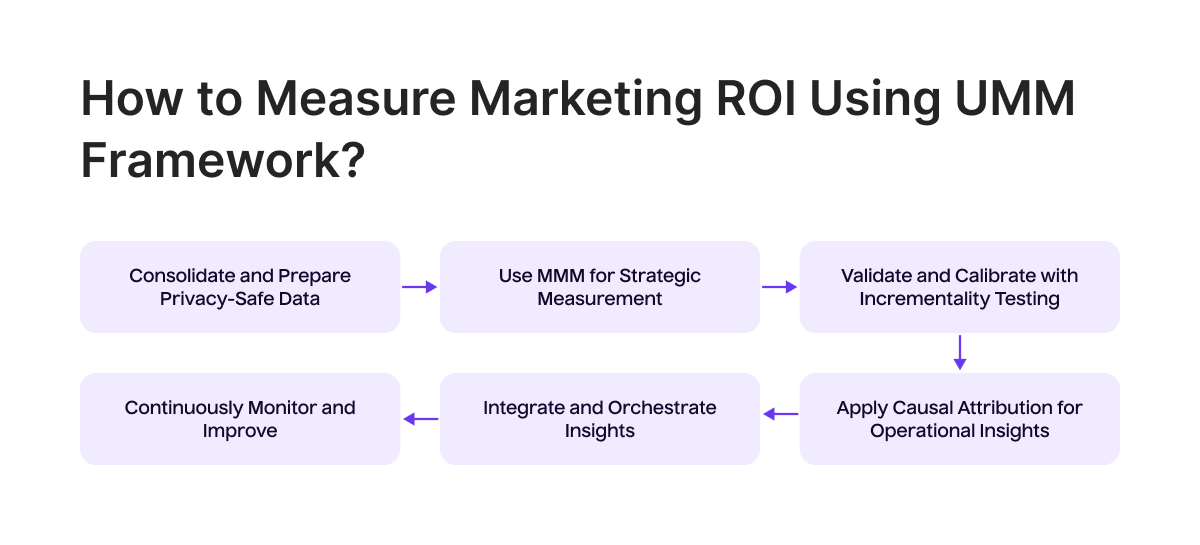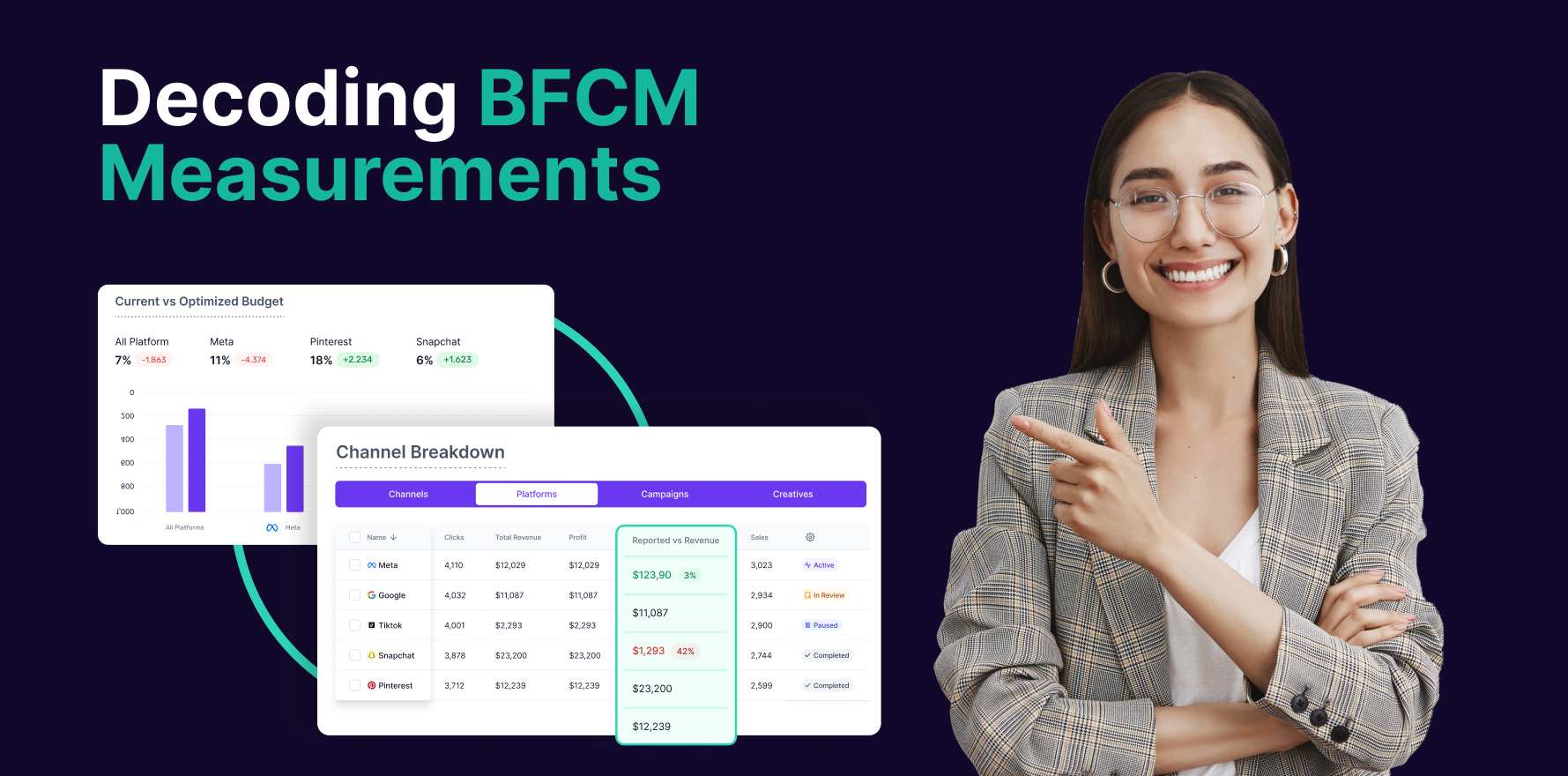Every marketing dollar should work toward driving measurable business results. Executives want proof that those investments pay off. Marketing ROI (MROI) provides that proof by showing how much profit or revenue marketing generates compared to its cost.
In other words:
For every dollar we spend, how much do we get back?
Measuring MROI not only justifies budgets but also guides smarter resource allocation, aligns marketing with business goals, and informs strategies for future growth.
But here’s the catch: With fragmented data, multiple touchpoints, and shifting market conditions, accurate ROI measurement is tricky. Traditional models often miss the full picture, making Unified Marketing Measurement (UMM) a modern, privacy-compliant necessity.
What is Marketing ROI?
Marketing ROI (Return on Investment) is a revenue metric that measures how much revenue or profit generated for an overall business as a direct result of marketing campaigns and activities, relative to the cost of those efforts.
Here are two formulas to measure marketing ROI
1. ROI / ROMI = Profit-based measure
ROI = Net or Gross Profit from Marketing / Total Marketing Cost x 100
2. ROAS = Revenue-per-ad-dollar
ROAS = Ad Revenue / Ad Spend
Note: Use ROI when evaluating overall profitability (including costs). Use ROAS when measuring revenue efficiency of ad spend.
ROI vs ROAS
ROI (Return on Investment) measures profitability by comparing net or gross profit to the cost of marketing. ROAS (Return on Ad Spend) measures revenue generated per dollar spent on ads, without subtracting costs like production or operations. ROI shows true financial gain, while ROAS shows revenue efficiency.
Why Should Businesses Measure Marketing ROI?
Businesses should measure marketing ROI to get a clear understanding of their financial impact and effectiveness of their marketing efforts.
It helps marketers to take the following confident decisions;
1. Justify your marketing investment
- As a marketer, you need to justify every dollar you spend. By measuring ROI, you can clearly show the return each campaign brings to the business.
- When you can directly link marketing activities to revenue or profit, it becomes much easier to defend budgets and demonstrate that marketing is a revenue driver and not just a cost center.
2. Allocate budgets effectively
- When you understand which campaigns, channels, or strategies deliver the highest ROI, you can direct more resources toward them.
- This ensures the budget is allocated to efforts that actually move the needle while reducing spend on low-performing tactics.
3. Links marketing and business goals
- Measuring ROI ensures that marketing activities are directly contributing to broader organizational objectives such as revenue growth, profitability, or customer retention.
- It also fosters alignment between marketing, sales, and leadership teams by focusing everyone on measurable outcomes.
4. Improve your future marketing ROI
- Tracking ROI over time allows marketers to spot patterns, test new ideas, and refine strategies.
- By learning from both successes and failures, you can increase efficiency, boost returns, and achieve a higher ROI in future campaigns.
Why is Marketing ROI Difficult to Measure?
1. Multiple marketing touchpoints
Customers often discover and interact with a brand through several channels before making a purchase. This scenario, known as multi-touch attribution, makes it challenging to determine which marketing channel or effort deserves credit for the sale.
Example of a Real-World Challenge:
A customer is interested in buying a perfume. They start by searching for perfumes on Google and see Google Shopping ads. Later, they notice an Instagram ad for the same brand. A few days later, they spotted a billboard promoting it. Finally, they walk into a physical store and purchase the perfume.
In this case, should the credit go to Google Shopping ads, the Instagram ad, the billboard, or the in-store experience? Accurately assigning credit across these touchpoints is one of the most difficult parts of measuring marketing ROI.
2. Data fragmentation and Siloed tools
Marketing data is often scattered across different platforms such as Google Analytics, CRM systems, social media dashboards, and ad managers.
When these tools do not integrate seamlessly, marketers cannot get a complete view of the customer journey. This makes ROI measurement inaccurate.
Example of a Real-World Challenge:
An online clothing retailer uses Google Ads for paid campaigns, HubSpot for email marketing, and Shopify for sales. Each platform tracks its own metrics, but without proper integration, it is unclear which customer actions led to the final purchase. This fragmented data makes calculating true marketing ROI difficult.
3. External factors
Sales performance is influenced not just by marketing but also by external factors like seasonality, competitor activities, economic changes, or global events. These external influences can make it hard to isolate the true impact of marketing on revenue.
Example of a Real-World Challenge:
A travel agency launches a paid social media campaign to promote vacation packages. During the same period, there is a sudden spike in travel demand due to easing visa rules. The sales increase, but it is unclear how much is due to the marketing campaign versus the market trend.
4. Difficulty in benchmarking the baseline
Accurate ROI measurement requires knowing the baseline performance, meaning the expected results without any marketing efforts. Establishing this “would-have-happened-anyway” number is often challenging, especially for ongoing campaigns.
Example of a Real-World Challenge:
A SaaS company launches a new content marketing strategy while continuing its usual email campaigns. Without knowing how many sign-ups would have occurred from the email campaigns alone, it is difficult to measure the real impact of the new content strategy.
5. Brand impact is hard to quantify
Strong brands often generate sales due to their reputation and market influence, regardless of ongoing marketing efforts. This makes it challenging to measure how much revenue comes from active campaigns versus the brand’s existing strength.
Example of a Real-World Challenge:
Take a globally recognized brand like Apple. Almost everyone knows Apple launches a new iPhone every year. Whether a marketing campaign is running or not, millions of loyal customers will still line up to buy it. In this case, it becomes difficult to quantify how much of the sales are driven by marketing activities and how much comes from Apple’s established brand influence.
6. Long sales cycles
In industries where purchase decisions take months or even years, connecting a marketing activity to the final sale can be difficult. The longer the sales cycle, the more complex the attribution becomes.
Example of a Real-World Challenge:
An industrial machinery company runs a LinkedIn ad targeting manufacturing businesses. A prospect clicks the ad, books a consultation, and eventually signs a contract 10 months later. Over such a long timeline, it becomes harder to tie the sale directly to the initial ad spend.
7. Measuring customer lifetime value
For subscription-based or repeat-purchase businesses, the true ROI is tied to the total value a customer generates over their entire relationship with the company. This requires predicting future behavior, which is inherently uncertain.
Example of a Real-World Challenge:
A meal-kit subscription service spends $50 to acquire a new customer. In the first month, the customer spends $80. While the short-term ROI appears small, the customer might stay for 12 months, generating far more value. Accurately projecting this lifetime value is important but challenging.
How to Calculate Marketing ROI? Formulas with Examples
1. Basic Marketing ROI formula
Marketing ROI = Revenue from Marketing − Marketing Cost / Marketing Cost × 100%
Example:
A company sells premium skin care products. They run a three-month Facebook ad campaign to promote their new anti-aging cream.
- Revenue from a marketing campaign: $50,000
- Marketing cost: $10,000
Marketing ROI = 50,000 − 10,000 / 10,000 × 100% = 400%
Result: For every $1 the company spent on the campaign, it earned $4 in profit from sales of the anti-aging cream.
Note: Basic ROI based on revenue can be misleading if your cost of goods sold (COGS) is significant. For a truer view of profitability, calculate gross-margin ROI by using gross profit (revenue minus COGS) instead of total revenue in the formula. This ensures ROI comparisons account for varying margins across products or sectors.
2. ROI with Gross Profit
Sometimes businesses use gross profit instead of revenue to get a more accurate picture, since it accounts for the cost of goods sold (COGS).
Marketing ROI = Gross Profit from Marketing − Marketing Cost / Marketing Cost x 100%`
Example:
A company selling handmade leather bags runs a Google Ads campaign to promote a limited-edition collection.
- Revenue from campaign: $50,000
- COGS: $20,000
- Gross Profit = $50,000 – $20,000 = $30,000
- Marketing cost: $10,000
ROI = 30,000 − 10,000 / 10,000 × 100% = 200%
Result: Every $1 spent on marketing returned $2 in profit after covering production costs.
3. ROI Using Customer Lifetime Value (LTV)
For subscription or repeat-purchase businesses, ROI should consider the total value a customer brings over time, not just the first sale.
Marketing ROI = (Number of New Customers × LTV) − Marketing Cost / Marketing Cost × 100%
Example:
A subscription-based meal delivery company runs a YouTube ad campaign targeting urban professionals.
- New customers from campaign: 100
- Average LTV per customer: $500
- Total value = 100 × $500 = $50,000
- Marketing cost: $15,000
Marketing ROI = 50,000 − 15,000 / 15,000 × 100 = 233%
Result: Over the customer’s lifetime, every $1 spent on marketing will return about $2.33 in profit.
4. Digital Marketing ROI with Attributed Conversions
In digital campaigns, you often calculate ROI using tracked conversions from analytics tools.
ROI = (Average Order Value × Number of Conversions) − Marketing Cost / Marketing Cost × 100
Example:
An online fashion retailer runs an Instagram ad campaign to promote its summer collection.
- Average order value: $100
- Number of conversions: 500
- Marketing cost: $20,000
Revenue from conversions = 500 × $100 = $50,000
ROI = 50,000 − 20,000 / 20,000 × 100% = 150%
Result: The campaign returned $1.50 in profit for every $1 spent.
Annualized ROI for Duration Adjustments
Campaigns of different lengths can’t be compared directly without adjusting for time.
For example, a 3-month campaign with 50% ROI is stronger than a 12-month campaign with the same 50% ROI because the shorter campaign could be repeated or scaled within the year.
To compare fairly, calculate annualized ROI:
Annualized ROI = (1+ROI) 12/ campaign months − 1
Annualizing ROI standardizes returns to a yearly rate, making it easier to judge which campaigns truly perform best over time.
Compare apples-to-apples: use margin-adjusted ROI and, for multi-period programs, annualized ROI.
Measuring Marketing ROI Across Channels
Measuring marketing ROI across multiple channels is more challenging than tracking ROI for a single campaign. Customers rarely stick to one platform. They may see a Facebook ad, read a blog post, click a Google ad, and finally convert after receiving an email.
When channels overlap, traditional last-click attribution often fails to show the full picture. One channel might appear more effective than it actually is, while another gets undervalued. With privacy regulations like GDPR and CCPA, and browser restrictions on cookies, user-level tracking across channels has become far less reliable.
To accurately measure ROI across channels in today’s environment, businesses need to:
- Consolidate data from all marketing platforms into a single, privacy-compliant view.
- Use modern attribution methods such as Marketing Mix Modeling (MMM) combined with incrementality testing and causal attribution, rather than relying on outdated multi-touch attribution.
- Factor in both online and offline touchpoints using aggregated or modeled data.
- Include brand impact and customer lifetime value, not just immediate conversions.
This is where the Unified Marketing Measurement (UMM) approach, built on privacy-safe analytics, becomes essential.
Unified Marketing Measurement (UMM) Framework for Measuring Marketing ROI
The Unified Marketing Measurement (UMM) framework is a privacy-first, integrated approach to measuring marketing effectiveness across all channels. It combines three complementary methodologies:
1. Marketing Mix Modeling (MMM)
A top-down statistical method that uses aggregated, privacy-safe data to estimate the modeled incremental contribution of each marketing channel, online and offline, over time. Because MMM is based on historical, modeled data, its accuracy must be calibrated with real-world experiments to ensure the estimates reflect true causality.
Read More: Marketing Mix Modeling (MMM): A Guide for CMOs and Marketers
2. Incrementality Testing
Controlled experiments (such as geo-tests or split-tests) that directly measure the causal lift from specific marketing activities. These tests validate and refine the MMM model, closing the gap between statistical estimates and actual performance.
Read More: What is Incrementality Testing? A Guide for Marketers
3. Causal Attribution
A privacy-compliant evolution of attribution that uses aggregated or modeled data to provide granular, near real-time insights for operational decision-making.
By combining MMM’s long-term, modeled insights with experiment-based calibration and near real-time attribution, UMM delivers a holistic, accurate, and actionable view of marketing ROI from strategic budget planning to in-flight campaign optimization.
Read More: Causal Attribution in Marketing: What Is It and How Does It Work?
How to Measure Marketing ROI Using UMM Framework?
In the previous section, we explored the challenges businesses face in measuring marketing ROI. To overcome these issues, we introduce the Unified Marketing Measurement (UMM) framework, a privacy-first approach that combines Marketing Mix Modeling (MMM), Incrementality Testing, and Causal Attribution to deliver accurate and actionable ROI insights.
Here’s a step-by-step guide on how to measure marketing ROI using the UMM framework, along with how each step addresses modern measurement challenges:
STEP 1: Consolidate and Prepare Privacy-Safe Data
Bring together aggregated data from all marketing platforms, sales systems, and offline channels into a single source of truth. This unified dataset removes silos and ensures all insights are based on privacy-compliant data.
The UMM platform collects and unifies siloed data from tools like Ads Manager, Google Analytics, email dashboards, CRM platforms, and sales systems, bringing everything under one roof. Marketers can now view all campaign performance in one place without needing to manually reconcile disconnected reports.
STEP 2: Use MMM for Strategic Measurement
Apply Marketing Mix Modeling (MMM) to estimate the modeled incremental contribution of each channel to business outcomes. MMM analyzes historical, aggregated, privacy-safe data and accounts for adstock effects, saturation, seasonality, and external factors, providing a long-term, holistic view of marketing performance across both online and offline channels.
Because MMM is based on statistical modeling rather than direct experimentation, its outputs must be validated and calibrated with real-world incrementality tests (see Step 3). This ensures the modeled estimates align with actual causal impact.
Beyond measurement, MMM delivers actionable insights such as recommended budget allocations and optimal spend levels for each channel. These strategic recommendations form the foundation for experimentation.
STEP 3: Validate and Calibrate with Incrementality Testing
Based on MMM’s modeled insights, marketers should design and run controlled experiments such as geo-holdouts or split-tests to measure actual causal lift from specific marketing activities.
These tests are critical for calibrating the MMM model, improving its accuracy, and closing the gap between modeled estimates and real-world performance. The results are then fed back into MMM for recalibration, ensuring future recommendations are grounded in both statistical evidence and observed outcomes.
Incrementality testing also solves one of the hardest measurement challenges: knowing what would have happened without the marketing activity. By establishing a reliable baseline, marketers can avoid over-crediting or under-crediting channels based on assumptions rather than evidence.
STEP 4: Apply Causal Attribution for Operational Insights
Use aggregated or modeled attribution data to track performance at a granular level in near real time. This method enables daily campaign optimizations while respecting privacy rules and avoiding outdated user-level tracking.
With causal attribution, marketers can connect multiple marketing touchpoints without relying on invasive tracking. Instead of guessing which ad or channel made the difference, causal attribution statistically identifies the touchpoints that truly influenced conversions, enabling better in-flight decision-making while staying compliant with GDPR, CCPA, and other privacy regulations.
STEP 5: Integrate and Orchestrate Insights
Combine insights from MMM, incrementality testing, and causal attribution into a single, unified view. Use this to guide strategic planning, reallocate budgets effectively, and optimize campaigns at the channel, ad set, and creative level.
This unified approach means marketers no longer need to piece together fragmented reports from separate tools. Instead, they can see long-term contribution, verified causal lift, and current in-flight performance in one view, enabling confident budget shifts and strategy adjustments.
STEP 6: Continuously Monitor and Improve
Regularly update models with fresh data, rerun experiments when needed, and watch for model drift. This continuous feedback loop keeps recommendations relevant as market conditions and customer behavior evolve.
By maintaining an ongoing refresh cycle, marketers avoid the risk of relying on outdated assumptions. As market dynamics change, whether from new competitors, shifting consumer habits, or macroeconomic events, the UMM framework adapts to keep ROI measurement accurate and decision-making data-driven.
Important Metrics to Track Marketing ROI
1. Return on Investment (ROI)
Formula: (Revenue from Marketing − Marketing Cost) / Marketing Cost × 100 %
Measures overall profitability of marketing spend.
2. Return on Ad Spend (ROAS)
Formula: Revenue from Ads / Advertising Cost
Focuses on revenue generated for every dollar spent on ads.
3. Incremental Return on Ad Spend (iROAS)
Formula: Incremental Revenue from Ads/Ad Spend
Measures the additional revenue directly caused by ad spend, isolating campaign lift from organic or baseline sales.
4. Marginal ROAS (mROAS)
Formula: Incremental Revenue from Last Spend Unit/Cost of Last Spend Unit
Shows the return from the next dollar spent, used for optimizing budget allocation.
5. Return on Marketing Investment (ROMI)
Formula: (Incremental Revenue−Marketing Investment)/Marketing Investment×100%
Similar to ROI, but focuses on incremental returns rather than total returns.
6. Customer Acquisition Cost (CAC)
Formula: Total Marketing + Sales Costs/Number of New Customers
Indicates the average cost to acquire a new customer.
7. Customer Lifetime Value (CLV or LTV)
Formula: Average Purchase Value×Purchase Frequency×Customer Lifespan
Predicts the total revenue a customer brings over their relationship with the brand.
8. Conversion Rate
Formula: (Conversions/Total Visitors)×100%
Measures how effectively marketing turns interest into action.
9. Cost per Conversion (CPC or CPA)
Formula: Total Marketing Spend/Number of Conversions
Tracks cost efficiency of generating desired actions.
10. Cost per Lead (CPL)
Formula: Marketing Spend / Number of Leads Generated
Shows the cost of generating one lead.
11. Incremental Cost per Lead (ICPL)
Formula: Incremental Marketing Spend / Incremental Leads Generated
Indicates the cost of generating each additional lead from increased marketing spend.
12. Incremental Engagement Rate
Formula: (Engagements from Campaign−Baseline Engagements)/Total Audience Reached×100%
Measures engagement uplift caused directly by a marketing initiative.
13. Engagement Metrics (Supportive)
Click-through rate (CTR), time on page, bounce rate explain ROI context.
Best Practices to Measure Marketing ROI
1. Align marketing goals with business objectives
Ensure every campaign is tied to measurable business outcomes such as revenue growth, profitability, or customer retention.
Link marketing metrics to strategic goals so marketing is seen as a revenue driver, not just a cost center.
2. Implement robust tracking mechanisms
Consolidate data from all marketing, sales, and offline channels into a single, privacy-compliant source of truth.
Use integrated tools and frameworks like the Unified Marketing Measurement (UMM) approach to break down silos and ensure accuracy.
Tag campaigns consistently to track customer interactions across touchpoints.
3. Choose the right attribution model
Move beyond outdated last-click attribution; use a mix of Marketing Mix Modeling (MMM) for strategic insights, Incrementality Testing to prove causality, and Causal Attribution for near real-time optimization.
Account for multi-touch journeys, external factors, and long sales cycles to get a realistic view of impact.
4. Focus on revenue key performance indicators (KPIs)
Prioritize metrics that reflect true business value: ROI, Customer Lifetime Value (CLV), Customer Acquisition Cost (CAC), and incremental revenue.
Where applicable, factor in both immediate conversions and the long-term contribution of customers.
Avoid relying solely on vanity metrics like clicks or impressions unless tied to revenue impact.
5. Measure and optimize continuously
Refresh models regularly with new data, rerun experiments, and adjust for market changes to keep ROI measurement accurate.
Use insights to reallocate budgets to high-performing channels and refine creative, targeting, and spend.
Maintain a feedback loop so ROI measurement evolves with customer behavior, market dynamics, and privacy requirements.
Tools to Measure Marketing ROI
Tool |
Platform |
Key Features |
Best For |
Best Industries |
| Lifesight | Unified Marketing Measurement Platform | Combines MMM, Incrementality Testing, and Causal Attribution; privacy-first; integrates online and offline data | Businesses seeking a single source of truth for cross-channel measurement and Recommend Insights for Budget Allocation and Campaign Optimization | Retail, eCommerce and B2B SaaS |
| Measured | Marketing Effectiveness Platform | Media optimization, incrementality testing, cross-channel attribution | Marketers focused on proving true causal lift from media spend | DTC Brands, eCommerce, Subscription Services, Retail |
| Haus | Marketing Science Platform | Predictive analytics, media testing, performance forecasting | Brands wanting test-driven marketing strategy validation | Media & Entertainment, Retail, eCommerce, Consumer Technology |
| Recast | Incrementality Platform | Fast modeling, Bayesian incrementality testing, adaptive budget recommendations | Teams needing quick, statistically robust insights for budget shifts | SaaS, eCommerce, Retail, Fintech |
How Lifesight’s UMM Helps Business to Measure Marketing ROI?
Lifesight is a leading Unified Marketing Measurement (UMM) platform that brings together Marketing Mix Modeling (MMM), Incrementality Testing, and Causal Attribution into a single, privacy-first measurement solution.
This integrated approach directly addresses the modern ROI measurement challenges mentioned in the challenges section, such as fragmented data, multiple touchpoints, attribution complexity, external market factors, and privacy restrictions.
With Lifesight’s UMM, businesses can:
1. Eliminate Data Silos
- Consolidate marketing, sales, and offline data into one unified, privacy-compliant view.
- Remove the guesswork caused by fragmented analytics tools.
2. Boost ROAS and ROMI
- Use data-driven budget allocation to prioritize high-performing channels and campaigns.
- Identify underperforming spend early and reallocate for maximum return.
3. Optimize Spend Levels
- Apply MMM insights to find the optimal investment threshold for each channel.
- Avoid diminishing returns by adjusting budgets to match performance saturation points.
4. Eliminate Wasted Ad Spend
- Identify campaigns, channels, or audience segments that do not generate incremental results.
- Redirect budgets from low-impact areas to initiatives with proven ROI.
5. Prove True Incrementality
- Run incrementality tests to measure the actual lift from marketing campaigns versus baseline performance.
- Confidently attribute revenue to the right activities.
6. Forecast Revenue Before Campaigns Launch
- Use historical data modeling and predictive analytics to estimate campaign ROI in advance.
- Make investment decisions backed by evidence, not assumptions.
7. Enable Continuous Optimization
- Combine strategic, experimental, and operational insights for ongoing campaign adjustments.
- Ensure marketing performance remains aligned with evolving market conditions and business goals.
Conclusion
Marketing ROI (MROI) measures how much revenue or profit marketing generates compared to its cost, answering the critical question: “For every dollar we spend, how much do we get back?”
In today’s complex, multi-channel landscape, measuring ROI is challenging due to fragmented data, multiple touchpoints, external influences, and long sales cycles. Traditional attribution models often fail to capture the full picture.
The solution is Unified Marketing Measurement (UMM), which combines Marketing Mix Modeling (MMM), Incrementality Testing, and Causal Attribution to deliver accurate, privacy-compliant insights. Platforms like Lifesight’s UMM help businesses consolidate data, optimize spend, forecast revenue, boost ROAS and ROMI, and eliminate wasted ad spend.
By mastering ROI measurement, marketers can make smarter budget decisions, align efforts with business goals, and transform marketing into a proven growth engine.
FAQs
1. What is a good marketing ROI benchmark?
A frequently cited benchmark is a 5:1 revenue-to-cost ratio (~400% ROI), meaning you generate five dollars in revenue for every dollar spent. Treat this figure as directional rather than universal. Actual ROI varies significantly by industry, business model, and gross margin.
For example, lower-margin sectors may need a higher ratio to be profitable, while high-margin businesses can sustain lower ratios. Some studies place typical ranges between 2:1 and 10:1 depending on the sector and payback period (HubSpot, 2023). When comparing performance, adjust for your gross-margin–adjusted ROI and your sales cycle length to get a true apples-to-apples measure.
2. What costs should be included when calculating Marketing ROI?
Include ad spend, creative production, tools, personnel, agency fees, and any campaign-related expenses.
3. How often should Marketing ROI be measured?
Measure regularly like monthly, quarterly, and at campaign end based on your sales cycle length.
4. Is Marketing ROI the best metric to measure marketing success?
It’s critical for financial impact but should be paired with engagement, brand, and retention metrics for a full picture.
5. How does Marketing ROI differ from other performance metrics (e.g., ROAS, CPA)?
ROI measures overall profitability, ROAS focuses on ad revenue vs. spend, and CPA shows cost per conversion.
6. What data do I need to measure Marketing ROI effectively?
Accurate revenue, cost, attribution, conversion, and customer lifetime value (CLV) data from integrated sources.
7. How do I attribute revenue to specific marketing campaigns?
Use attribution models like first-touch, last-touch, multi-touch, or advanced methods like MMM and causal attribution.
8. How do I deal with multi-touch attribution in ROI measurement?
Apply multi-touch or unified measurement frameworks to fairly distribute credit across all influencing channels.
9. What are common mistakes in calculating Marketing ROI?
Ignoring indirect costs, over-crediting single channels, and not accounting for baseline or external factors.
10. How can I measure ROI across multiple channels?
Consolidate data into a single view and use methods like UMM or MMM for cross-channel performance analysis.
11. How do I account for long-term marketing efforts in ROI?
Include brand equity, CLV, and lagged effects through long-term modeling like MMM.
12. Can I measure ROI from organic (non-paid) marketing efforts?
Yes, by attributing revenue from organic traffic, SEO, and social engagement to the time and resources invested.
13. How do I measure ROI for content marketing or SEO?
Track conversions, leads, and revenue influenced by content, comparing gains to content creation and distribution costs.
14. How does marketing ROI differ from ROAS (Return on Ad Spend)?
ROI covers all marketing investments and profitability; ROAS measures only ad-driven revenue vs. ad spend.
15. Is it possible to measure marketing ROI for offline campaigns?
Yes, using tracking methods like promo codes, unique phone numbers, surveys, or offline attribution models.
Essential resources for your success




















































